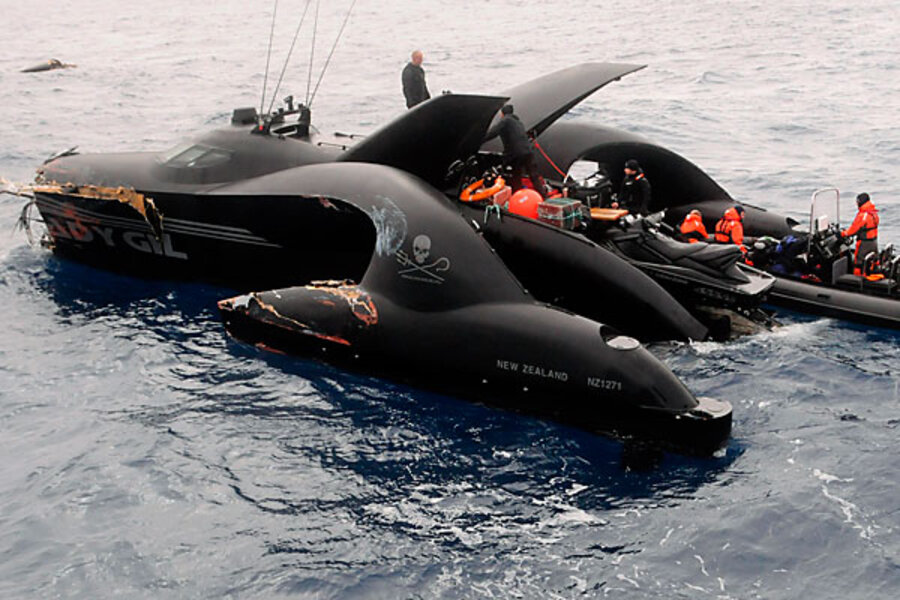Whale Wars: Investigation into the sinking of Sea Shepherd Ady Gil
Loading...
| Boston
The undisputed fact is that the Ady Gil, a carbon-fiber trimaran that set a circumnavigation record before being converted into an anti-whaling ship, collided with the much larger Japanese ship Shonan Maru Number 2 on Tuesday. The collision lopped off the Gil's bow and set off a war of words.
Paul Watson, Sea Shepherd leader and a militant antiwhaling and sealing activist, likened the collision to an act of war. The Japanese government has protested that relentless harassment made a damaging collision almost inevitable.
Japan's Institute of Cetacean Research (ICR), which runs the hunt for the Japanese government under the auspices of scientific research, notwithstanding that the meat is sold for human consumption, charged in a press release: "The Sea Shepherd extremism is becoming more violent. Their actions are nothing but felonious."
The videos, based on readers' comments to earlier posts on the collision, appear inconclusive, with multiple readers saying the Japanese vessel clearly targeted the Gil and multiple others saying the Gil clearly steered across the Maru's bow (YouTube video of the incident from the Maru's perspective here and from a nearby Sea Shepherd boat here).
Now, both Australia, which is responsible for search-and-rescue operations in that part of the Southern Ocean, and New Zealand, under whose flag the Gil was sailing, have announced they'll investigate the collision.
"The New Zealand government is totally opposed to Japanese whaling taking place in the Southern Ocean, but we're also opposed to killing human beings down there as well," New Zealand's Foreign Minister Murray McCully said Thursday.
In Australia, Deputy Prime Minister Julia Gillard refused to assent to local environmentalists' demands to send a ship to the area to monitor the whaling. She said that Australia's decision to send a monitoring ship in 2008 may have provoked a greater confrontation, since it provided a bigger audience for Mr. Watson's crew. "Some might suggest that the presence of the vessel monitoring and observing emboldened actions and we certainly wouldn't want to see that," Ms. Gillard said.
If the loss of the Gil, which is being salvaged for valuable parts by the Sea Shepherd's larger vessel, the Bob Barker, ends up in court, the Japanese are likely to point to the large library of videos the ICR has collected on the way the Gil and other Sea Shepherd vessels have sported with their fleet. The below video, taken shortly before Christmas, is of the Gil seeking to use a laser to blind the the crew of the Maru and cutting across its bow to drop cables to foul its propeller.
The media-savvy Watson would be likely to use any court hearing to press his case that all whaling should be illegal and that the Japanese are in fact, as he describes them, "poachers." How credible he'll be as a witness is less certain, since he's long urged environmentalists to mix deception with their advocacy. On page 43 of his self-published 1993 book "Earthwarrior," a tactical guide for environmentalists, he wrote: "If you do not know an answer, a fact, or a statistic, then simply follow the example of an American President and do as Ronald Reagan did. Make it up on the spot and deliver the information confidently and without hesitation."
Sea Shepherd charged earlier this week that the "Japanese ships initially refused to acknowledge the May Day distress of the Ady Gil, but ultimately did acknowledge the call. Despite acknowledging the call, they did not offer to assist the Ady Gil or the Bob Barker in any way."
The ICR said in a Jan. 6 press release that "the Japanese vessels Shonan Maru No. 2 and Yushin Maru No. 3 remain in the area for possible rescue support and further monitoring."





